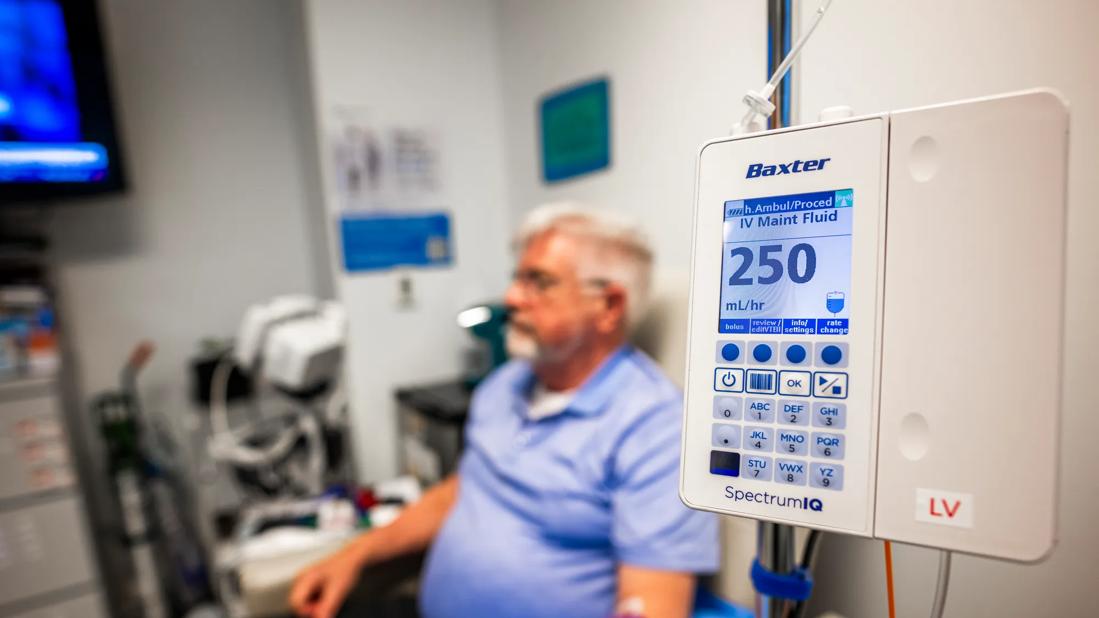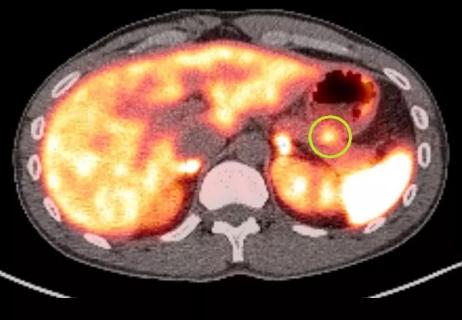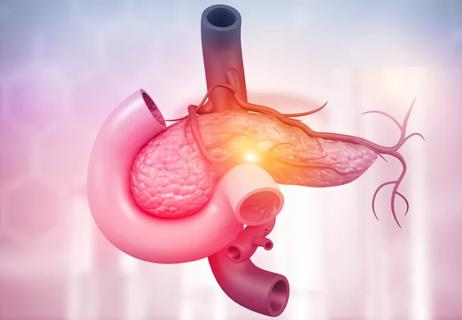A review of current evidence and recommendations

By Anusha Agarwal, MD, Arjun Chatterjee, MD, and Prabhleen Chahal, MD
Advertisement
Cleveland Clinic is a non-profit academic medical center. Advertising on our site helps support our mission. We do not endorse non-Cleveland Clinic products or services. Policy
Note: This article is reprinted from the Cleveland Clinic Journal of Medicine (2024;91[8]:466-468)
A 47-year-old female with a history of Type 2 diabetes and hyperlipidemia presents to the emergency room with a two-day history of nausea, vomiting and severe epigastric pain radiating to the back. The patient is hemodynamically stable, though she appears fatigued and diaphoretic. Physical examination reveals dry mucous membranes and epigastric tenderness. No leukocytosis or electrolyte abnormalities are noted. Her blood urea nitrogen level is 24 mg/dL (reference range 5–20 mg/dL), and serum creatinine is 1.3 mg/dL (0.6–1.2 mg/dL); these values are mildly elevated from baseline. Lipase is elevated at 1,200 u/L (0–160 u/L). Bedside ultrasonography of the right upper quadrant reveals gallstones. The patient meets the diagnostic criteria for acute pancreatitis and is admitted to the hospital for further management. Nothing by mouth status is ordered along with appropriate analgesic agents for pain control. What fluids should be ordered in this patient with acute pancreatitis?
The cornerstone of acute pancreatitis treatment is fluid resuscitation, early enteral nutrition as tolerated and analgesia. However, consensus for certain aspects of fluid resuscitation is lacking, especially regarding the type and volume of fluid. For years, early, aggressive fluid resuscitation was preferred. Limited, equivocal evidence supported the use of lactated Ringer’s solution vs normal saline in acute pancreatitis management. Data from recent studies, however, show that moderate fluid resuscitation is associated with fewer adverse events1 and that lactated Ringer’s may be superior to normal saline in acute pancreatitis management.2
Advertisement
Acute pancreatitis, an inflammatory condition of the pancreas, often precipitates a systemic inflammatory response, which can have a wide range of clinical consequences. More than 275,000 patients are hospitalized each year with acute pancreatitis, making it the third leading cause of hospitalization due to gastrointestinal disease in the United States and costing the U.S. healthcare system more than $2.6 billion annually.3
Several factors predispose patients to develop hypovolemia in acute pancreatitis. Third-spacing coupled with classic symptoms of vomiting, reduced oral intake and diaphoresis are frequent causes of hypovolemia in acute pancreatitis. Inflammation of the pancreatic parenchyma leads to recruitment of cytokines and other inflammatory molecules that increase vascular permeability, resulting in the movement of fluid from the intravascular space to the extravascular space. This inflammatory response activates numerous cascades, including pancreatic hypoperfusion, which, if persistent, can give rise to severe complications such as acinar cell death followed by pancreatic necrosis.4 Studies have shown that persistent hypovolemia in acute pancreatitis is associated with pancreatic necrosis, organ failure and poor outcomes. These findings correlate with data demonstrating improvement in morbidity and mortality with early fluid resuscitation.4,5 It is posited that early fluid resuscitation provides macro- and microcirculatory support to reduce the risk of the aforementioned catastrophic consequences.6
Advertisement
Early aggressive hydration in acute pancreatitis typically entails an initial fluid bolus followed by intravenous maintenance fluids at a rate of 250 to 500 mL/hour. This practice has been widely accepted in clinical settings, yet limited data exist to support it. Several randomized controlled trials, limited by small sample sizes and specific inclusion criteria, have demonstrated conflicting results for the role of aggressive fluid therapy in acute pancreatitis.6
The landmark WATERFALL (Early Weight-Based Aggressive vs Nonaggressive Goal-Directed Fluid Resuscitation in the Early Phase of Acute Pancreatitis) trial,1 published in 2022, sought to address this evidence gap by assessing the safety and efficacy of aggressive fluid resuscitation in patients with acute pancreatitis. In this multicenter, open-label, randomized controlled trial, aggressive fluid resuscitation consisted of a 20 mL/kg bolus followed by 3 mL/kg/hour maintenance, and moderate fluid resuscitation, a 10 mL/kg bolus, given only if the patient was clinically hypovolemic, followed by 1.5 mL/kg/hour maintenance. Patients with moderately severe or severe pancreatitis with signs of organ failure were excluded.1 Early aggressive fluid resuscitation led to a higher incidence of fluid overload (20.5% vs 6.3%) compared with moderate fluid resuscitation (adjusted relative risk 2.85, 95% confidence interval 1.36–5.94, P = .004), which notably led to early halting of the trial at the first safety checkpoint. The study also showed no significant difference in the overall health outcomes between the two fluid-resuscitation groups. Ultimately, the WATERFALL trial results favor the use of moderate fluid resuscitation in clinical practice, shifting the paradigm for early management of acute pancreatitis.
Advertisement
There are some caveats regarding the WATERFALL trial1 results. This trial excluded patients who are at higher risk for volume overload at baseline, such as patients with heart failure, cirrhosis, and chronic renal failure. Patients with moderately severe acute pancreatitis (organ failure that resolves within 48 hours or local or systemic complications without persistent organ failure) and severe acute pancreatitis (persistent organ failure [> 48 hours]), as defined by the revised Atlanta classification,7 were also excluded. In patients who meet the exclusion criteria from the WATERFALL trial and are prone to volume overload, cautious use of fluids with close monitoring of volume status is needed to avoid progression of acute pancreatitis and worsening of their baseline comorbid conditions.
In patients with moderately severe or severe acute pancreatitis who may not be prone to volume overload at baseline, the optimal amount of fluid resuscitation remains unclear. As such, biomarkers such as blood urea nitrogen, creatinine and hematocrit have been used as surrogate markers of successful hydration in patients with acute pancreatitis.4,8 Absolute cutoffs for these biomarkers have not been defined, and thus clinical judgment is needed when assessing a patient’s overall volume status during fluid resuscitation, especially within the first 48 hours.
While the importance of fluid resuscitation in acute pancreatitis is well established, uncertainty remains regarding which type of intravenous fluid should be given. Pilot trials have shown potential benefit of lactated Ringer’s over normal saline in achieving faster clinical recovery in mild acute pancreatitis9 and reducing the risk of intensive care unit admission.10 Studies have proposed that the perceived benefits of lactated Ringer’s over normal saline may be due to superior pH homeostasis with lactated Ringer’s infusion.11 Normal saline infusion can lead to hyperchloremic metabolic acidosis. The creation of an acidic environment makes acinar cells more susceptible to injury and enables inappropriate trypsinogen activation, a key step in acute pancreatitis pathogenesis.11 Nonetheless, these studies were limited by small sample size and lack of variation in disease severity, which impacted the generalizability of their results.9,10
Advertisement
To address this scarcity of data, Lee et al,2 using data from 999 patients with acute pancreatitis, conducted an observational study looking at the relationship between the type of intravenous fluid (lactated Ringer’s vs normal saline) administered within the first 24 hours and the development of moderately severe or severe acute pancreatitis. Analysis showed that lactated Ringer’s administration within the first 24 hours was associated with reduced odds of developing moderately severe or severe acute pancreatitis, thereby improving acute pancreatitis outcomes (adjusted odds ratio 0.52, P = .014).2 This well-powered study adds to the literature that supports lactated Ringer’s over normal saline in acute pancreatitis management. Nevertheless, the limitations of an observational study must be kept in mind. An adequately powered randomized controlled trial is needed to establish stronger evidence for the perceived benefits of lactated Ringer’s over normal saline in acute pancreatitis.
The hallmark for acute pancreatitis management remains early fluid resuscitation, analgesia and nutritional support. The landmark WATERFALL trial1 established that aggressive fluid resuscitation is associated with a higher incidence of volume overload with no significant improvement in health outcomes, favoring the strategy of moderate fluid resuscitation in clinical practice. Emerging data suggest that lactated Ringer’s is associated with improved health outcomes and hence may be superior to normal saline in acute pancreatitis management.1,2
REFERENCES
Advertisement

Patients spent less time in the hospital and no tumors were missed

Results underscore complex relationship among cellular pathways in the pathogenesis of the disease

Findings indicate clinical decision making should not be driven by initial lesion size

Patient’s unexplained low blood glucose levels in the absence of diabetes spark quest for answers

Pancreas and spleen removed to minimize risk of pancreatic cancer

Study reveals key differences between antibiotics, but treatment decisions should still consider patient factors

Key points highlight the critical role of surveillance, as well as opportunities for further advancement in genetic counseling

Potentially cost-effective addition to standard GERD management in post-transplant patients